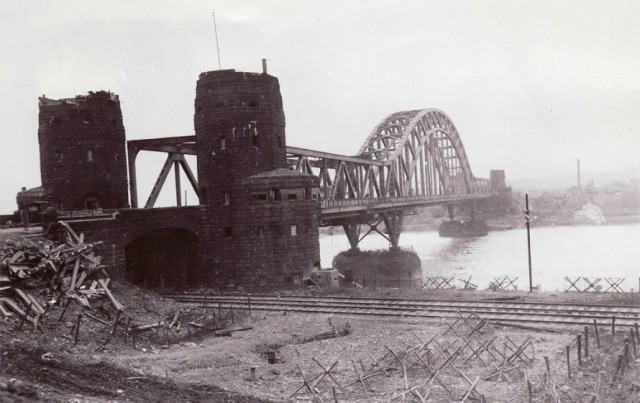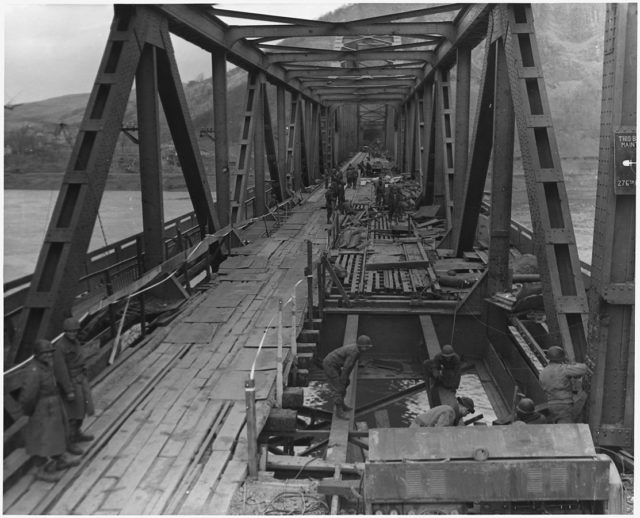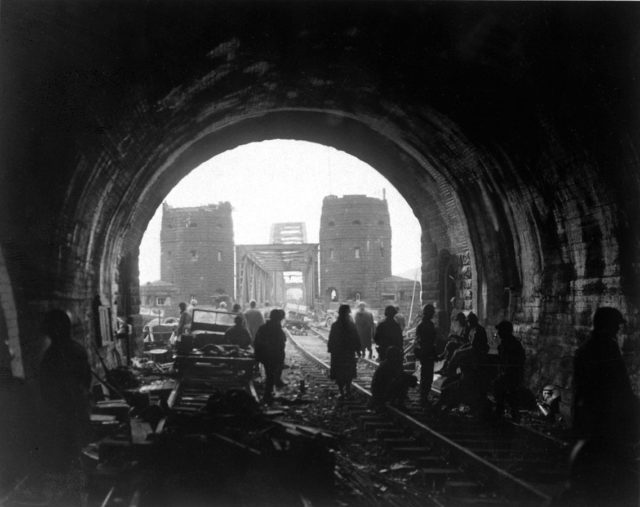On 7 March 1945, Allied troops captured the Ludendorff Bridge at Remagen. This surprise success allowed thousands of troops to cross the River Rhine and invade Germany.
The Bridge at Remagen
Founded in the 1st Century AD, the German town of Remagen sits on the Rhine, south of the city of Bonn.
A bridge across the Rhine at Remagen was originally included in the Schlieffen Plan used by Germany at the start of World War One. Its purpose was to carry troops and supplies across the Rhine for a German invasion of France. The bridge was due to be built in 1912, but this did not happen.
During the First World War, several German officers pushed for the bridge to be built so that it could supply forces on the Western Front. Work on the bridge began in 1916 and was completed in 1919, after the end of the war.
The bridge was named after General Erich Ludendorff, one of the highest profile advocates for its construction.

The bridge was built by Russian prisoners captured on the Eastern Front. Despite the cost saving of forced labor, construction cost 2.1 million marks.
The bridge was 398 meters long and consisted of three spans. At the eastern end was a 383-meter tunnel through the steep hill of Erpeler Ley. Stone towers guarded each end of the bridge, large enough to house a battalion of soldiers.
Plans for Destruction
The Ludendorff Bridge originally included cavities to hold demolition charges, so that the bridge could be destroyed before falling into enemy hands. After World War One the French occupied the Rhineland. During this time they filled the cavities with cement.

In 1938, Germany retook the bridge along with the rest of the Rhineland. They attached 60 boxes of explosives to the bridge’s girders, each holding 3.66 kilos of explosives.
By March 1945, these charges had been removed and stored nearby. Instead, 2,000 kilograms of explosives were placed in the west pier and two 300 kilo charges attached to girders linked to the east pier.
Attached to these charges was an electrical fuse controlled from the mouth of the Erpeler Ley tunnel. There was also a backup – a cord attached to the eastern explosives that could be lit manually.
Taking the Bridge

At 12:56 on 7 March 1945, scouts of the US 9th Armored Division arrived on a hill overlooking Remagen. They were part of the Allied advance on Germany. The division’s role was to capture the town and continue south. No-one expected to find an intact bridge.
The Ludendorff Bridge was still standing, the Germans using it to retreat across the Rhine. It was only lightly defended due to confusion among the retreating Germans.
Brigadier General William M. Hoge, commander of Combat Command B, 9th Armored Division, was the senior American officer present. He ordered his troops to seize the bridge. He did not know the strength of the Germans on the other side, or whether this might be a trap, but could not risk missing an opportunity to capture the only intact bridge across the Rhine.
The Germans were led by Captain Bratge. Under his command were about 1000 men. Some were men recovering from injuries. Others included engineers. Half were local Volksturm militia. Most lacked adequate training and equipment to defend the bridge.
Bratge wanted to destroy the bridge, but could not do so without written authorisation. Following an accident the previous year, Hitler had promised severe punishment on anyone who destroyed a bridge without permission. Captain Karl Friesenhahn, the engineering officer responsible for carrying out the demolition, received inadequate quantities of civilian grade explosives, rather than the military grade explosives meant to do the job.

At 1.50pm American infantry advanced on Remagen, followed half an hour later by tanks. They arrived in Remagen at the same time. The town’s defense relied on local conscripts. Most of the static defenses were too weak to withstand the tanks. The only serious problem was a machine gun stationed above the town square, which the American tanks quickly took out.
At 2 pm, Friesenhahn blew up a section of the approach to the bridge, to slow the Americans down. Bratge ran to find a superior officer and received the written demolition order he needed. Friesenhahn then insisted that Bratge gave him a further written order for the demolition.
At 3 pm the Americans learned that the bridge was scheduled to be destroyed at 4 pm.
The Americans launched white phosphorous shells across the river, creating a smokescreen for an advance.
At 3.20pm, Friesenhahn triggered the electrical fuse, but it had been damaged, and the explosives did not detonate.
A 3.50pm fire from Company A, 14th Tank Battalion, pushed the Germans off the bridge. An under-strength squad of infantry led by Second Lieutenant Timmermann advanced onto the bridge, despite the risk of being blown up with it, to seize it from the Germans.

At this moment, German Corporal Anton Faust braved Allied gunfire to run out of the Erpeler Ley tunnel and light the manual fuse. Only the charge on the southeast pier exploded, and the commercial explosives were not strong enough to bring the bridge down.
American troops advanced across the bridge under German fire, removing explosive charges as they went. First across the Rhine was Sergeant Alexander Drabik. He and his men had run down the center of the bridge, yet all reached the far bank uninjured.
The Americans quickly captured both ends of the Erpeler Ley tunnel, and the Germans inside surrendered.
The End of the Bridge

Despite a German counterattack, the American bridgehead across the Rhine held. Over the next ten days,
25,000 US troops together with tanks, trucks, and artillery crossed the Ludendorff Bridge. German attacks failed to destroy it. On 17 March it collapsed due to accumulated damage and the strain of massive use over the previous two weeks. 28 US Army Engineers died in the collapse.
